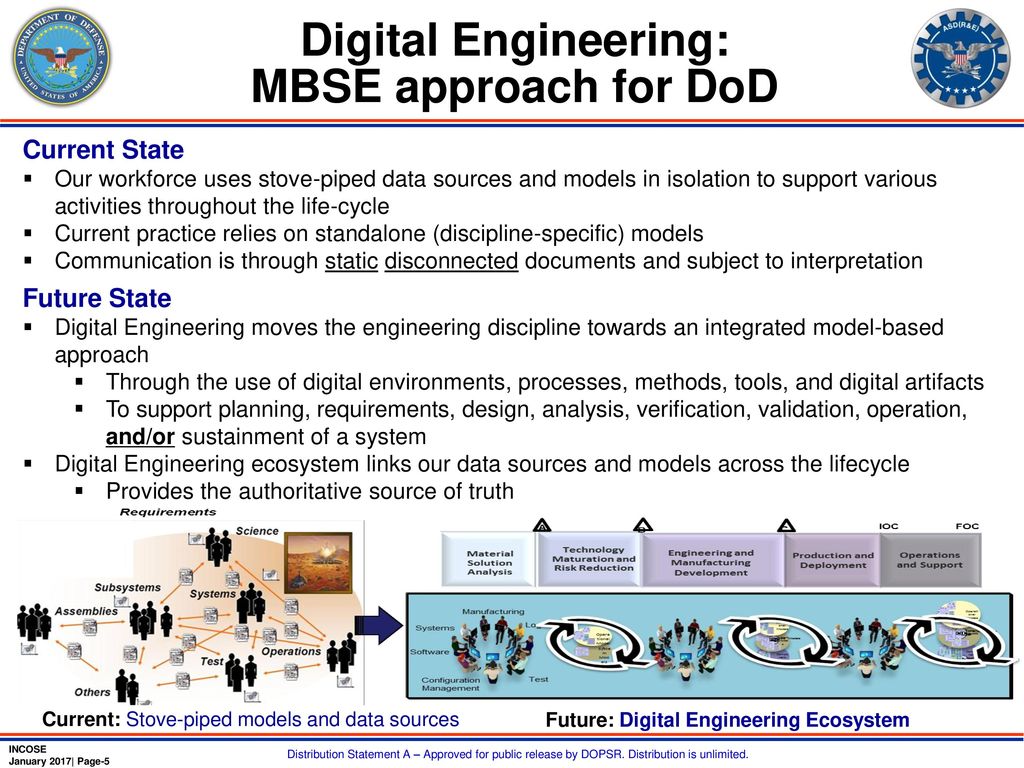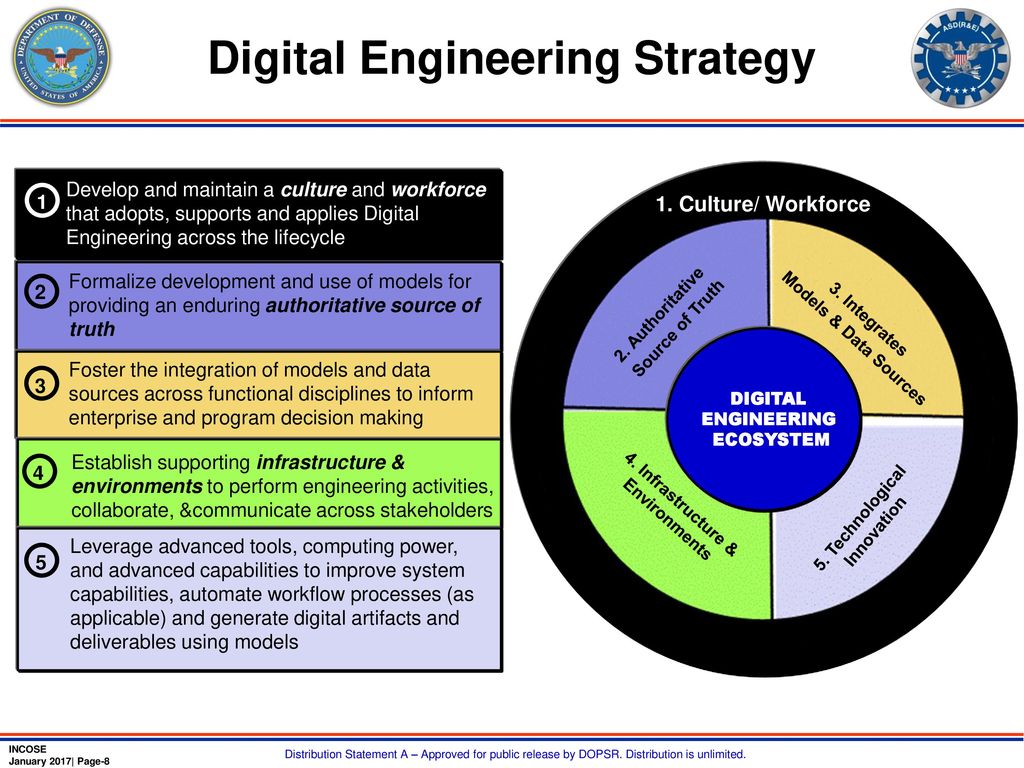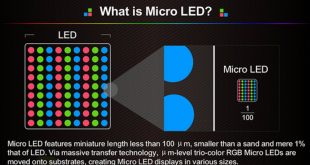A system is defined by NASA as a construct or collection of different elements that together produce results not obtainable by the elements alone. Systems Engineering (SE) is defined as: The process by which a customer’s needs are satisfied through the conceptualization, design, modeling, testing, implementation, and operation of a working system. It is an approach to help cope with the complexity inherent in systems, to help avoid omissions and invalid assumptions, manage real-world changing issues and produce the most efficient, economic and robust solution. Today, engineers and developers have fairly well codified the processes and techniques for building large, complex systems, and when executed properly, result in reliable and useful systems that serve users well.
MBSE is the formalized application of modeling to support system requirements, design, analysis, verification and validation activities beginning in the conceptual design phase and continuing through development and later life cycle phases. Model-Based Systems Engineering (MBSE) is a systems engineering methodology that focuses on creating and exploiting domain models as the primary means of information exchange between engineers, rather than on document-based information exchange. With the traditional approach of Document-Based Systems Engineering (DBSE), project and design information is stored in documents and must be manually maintained and transferred between domains The traditional DBSE approach is labor-intensive and consists mostly of manual analysis, review and inspection.
MBSE is an approach to systems engineering that looks to achieve the goals of systems engineering through the formal application of models. These models provide an efficient way to virtually prototype, explore, and communicate system aspects, while significantly reducing or eliminating dependence on traditional documents. By using interconnected models to store, represent and relate this information and data, MBSE promotes consistency, communication, clarity and maintainability within systems engineering projects and addresses issues associated with cost, complexity and safety.
Models are used to explore the structure, behavior, and operational characteristics of system elements, evaluate design alternatives, and validate assumptions faster and earlier in the system life cycle. This is particularly useful for large and complex systems—satellites, aircraft, medical systems, and the like—where the solution must be proven practical beyond all possible doubt before, for example, launching into space or connecting to the first patient. Models also record and communicate decisions that will be useful to others. This information serves as documentation for Compliance, impact analysis, and other needs.
US DOD’s Digital Engineering Strategy
The U.S. Department of Defense (DoD) requires robust engineering practices to develop the weapon systems the Nation needs to maintain superiority against threats from adversaries worldwide. Traditionally, the Department has relied on a linear process to develop complex systems that serve a range of missions and users. Often the acquisition engineering processes are document-intensive and stove-piped, leading to extended cycle times with systems that are cumbersome to change and sustain. The DoD faces the challenge of balancing design, delivery, and sustainment of complex systems with rapidly changing operational and threat environments, tight budgets, and aggressive schedules.
The US Under Secretary of Defense for Research and Development released the US Department of Defense (DoD) Digital Engineering Strategy in June 2018 describing five goals to streamline the DoD acquisition process through the creation of a digital thread enabling the conception, design, and development of complex weapon systems (DoD 2018; Zimmerman 2017). The crux of digital engineering is the creation of computer-readable models to represent all aspects of the system and to support all the activities for the design, development, manufacture, and operation of the system throughout its lifecycle. These computer models would have to be based on shared data schemata so that in effect a digital thread integrates all the diverse stakeholders involved in the acquisition of new weapon systems. The Digital Engineering Strategy anticipates digital engineering will lead to greater efficiency and improved quality of all the acquisition activities.
Current acquisition processes and engineering methods hinder meeting the demands of exponential technology growth, complexity, and access to information. To help ensure continued U.S. technological superiority, the Department is transforming its engineering practices to digital engineering, incorporating technological innovations into an integrated, digital, model-based approach, said Michael D. Griffin Under Secretary of Defense for Research and Engineering,

DOD is giving thrust to Digital Engineering (DE) (also known as model-based engineering or model-based systems engineering) is an initiative developed and championed by ODASD(SE) to help streamline the way defense programs collect, retain, and share data. ODASD(SE) asserts that digital engineering has the potential to promote greater efficiency and coherence in defense programs by ensuring stakeholders have access to accurate, relevant, and consistent information throughout the life of a program.
This DoD Digital Engineering Strategy outlines the Department’s five strategic goals for the digital engineering initiative. The strategy addresses a range of disciplines involved in the acquisition and procurement of national defense systems, and it encourages innovation in the way we build, test, field, and sustain our national defense systems and how we train and shape the workforce to use these practices.
It comprises of incorporating the use of digital computing, analytical capabilities, and new technologies to conduct engineering in more integrated virtual environments to increase customer and vendor engagement, improve threat response timelines, foster infusion of technology, reduce cost of documentation, and impact sustainment affordability. These comprehensive engineering environments will allow DoD and its industry partners to evolve designs at the conceptual phase, reducing the need for expensive mock-ups, premature design lock, and physical testing. This approach can enable DoD programs to prototype, experiment, and test decisions and solutions in a virtual environment before they are delivered to the warfighter.
Relationship with MBSE
Model-based systems engineering (MBSE) is a subset of digital engineering. MBSE supports the systems engineering activities of requirements, architecture, design, verification, and validation. These models would have to be connected to the physics-based models used by other engineering disciplines such as mechanical and electrical engineering. One challenge remaining for digital engineering is the integration of MBSE with physics-based models.
Foundation to digital engineering is the representation of the system data in a format sharable between all stakeholders (Giachetti et al. 2015; Vaneman 2018). SysML 2.0 is one of several future developments promising to provide a representation sufficient to support digital engineering. An ontology defining the entities and relationships between them can be used to define the concepts relevant to systems engineering. Such a representation is necessary to create the digital thread linking all the models together in a cohesive and useful manner.
This will enable the use of models throughout the lifecycle to digitally represent the system of interest (i.e., system of systems, systems, processes, equipment, products, parts) in the virtual world. Such ubiquitous use of models will result in a continuous end-to-end digital representation of the system of interest. This will upport consistent analysis and decision making for programs and across the enterprise. Models will be used as the basis for defining, evaluating, comparing, and optimizing alternatives and making decisions. The models will span all disciplines and will provide a unified representation that enables concurrent engineering and other program activities.
Models can provide a precise and versatile representation of a system, phenomenon, entity, or process. In early phases of the lifecycle, models enable virtual exploration of solutions before actually instantiating them. Over a solution’s lifecycle, models mature and can become useful replicates to physical counterparts for virtual testing and logistics sustainment support. Various disciplines and domains can concurrently operate on different aspects of the system in the virtual environment. Instead of discarding and redeveloping models, the collection of models evolves from one phase to the next. As a result, models live throughout the life span of the system.

Digital Engineering as a Transformation
For many organizations, digital engineering represents a transformation of how they normally conduct systems engineering (e.g., see Bone et al. 2018) since most organizations conduct a document-intensive systems engineering process. The adoption of digital engineering requires concomitant changes to how organizations perform system engineering activities. Everything from documenting requirements, technical reviews, architecture design, and so forth would be based on the models in a digital engineering environment (Vaneman and Carlson, 2019). The digital thread would be the authoritative source of truth concerning the system data.
DoD organizations will formally develop and implement plans to digitally represent the system of interest. This planning will establish an approach that uses models to enable the orchestration of activities, the efficient management of work, and the integration of work products across enterprises and multidisciplinary teams to result in a digital representation of the system of interest. This planning will set in place the formalisms which establish the foundational quality standards and rules (e.g., syntax, semantics, lexicons, standards, etc.) that model development will be expected to adhere to.
DoD organizations will develop formal plans for model creation, curation, integration, and related program and enterprise engineering activities throughout the lifecycle. The plans will describe how models will be realized in a coherent and effective manner as work activities are performed, and as analyses and decisions are supported.
The goals promote the use of digital representations of systems and components and the use of digital artifacts as a technical means of communication across a diverse set of stakeholders. This goal moves the primary means of communication from documents to digital models and data. This enables access, management, analysis, use, and distribution of information from a common set of digital models and data. As a result, authorized stakeholders have the current, authoritative, and consistent information for use over the lifecycle.
Incorporate technological innovation to improve the engineering practice. DoD will incorporate technologies such as advanced computing, big data analytics, artificial intelligence, autonomous systems, and robotics to improve the engineering practice. This goal extends beyond the traditional model-based approaches to incorporate advancements in technology and practice. Digital engineering approaches also supports rapid implementation of innovations within a connected digital end-to-end enterprise.
DoD’s approach is to securely and safely connect people, processes, data, and capabilities across an end-to-end digital enterprise. Establish a supporting infrastructure and environments to perform activities, collaborate, and communicate across stakeholders. This goal promotes the establishment of robust infrastructure and environments to support the digital engineering goals. It incorporates an information technology (IT) infrastructure and advanced methods, processes, and tools, as well as collaborative trusted systems that enforce protection of intellectual property, cybersecurity, and security classification.
Transitioning to digital engineering will address long-standing challenges associated with complexity, uncertainty, and rapid change in deploying and using U.S. defense systems. By providing a more agile and responsive development environment, digital engineering will support engineering excellence and provides a foundation to fight and win the wars of the future. Expected benefits of digital engineering include better informed decision making, enhanced communication, increased understanding of and confidence in the system design, and a more efficient engineering process
A digital twin is a related yet distinct concept to digital engineering. The digital twin is a high-fidelity model of the system which can be used to emulate the actual system. An organization would be able to use a digital twin to analyze design changes prior to incorporating them into the actual system.
A big component of digital engineering is multidisciplinary design optimization (MDO). It is key to develop disruptive and alternative concepts much faster and keep costs under control. Since MDO brings tools, processes, and people together, it is the only available method to fully explore and understand the entire design space, balance competing objectives and constraints, and ultimately find the optimal solution – all driven by intelligent computer algorithms.
USAF builds 6th generation fighter with Digital Engineering reported in Sep 2020
In Sep 2016, The US Air Force revealed that it has built and successfully flown a demonstration version of a new sixth-generation fighter jet. During a presentation at the annual Air Force Association conference, Roper mentioned the successful flight demonstration almost in passing. More interesting to him is the design process that led up to the production of the first airplane: It is the first major system to be produced via digital engineering.
The approach involves building an “eSystem” — a digital version of the real-world system the military plans to produce — and testing, prototyping and adapting it in a virtual world before the first physical system is ever built. The result, Roper said, is that the first real-world version that rolls off the assembly line is as good as the 100th would be under a more traditional acquisition and design approach. Roper said the “eSystem” approach would become the Air Force’s standard way of doing business from now on. Also, he released a how-to guide for “digital acquisition” to push his own workforce in that direction.
“Why would I ever want to create a new program where we didn’t go build an e-system? It’s truly magical,” he said. “It’s letting us do things I would have never thought of doing in the past, like killing the assembly learning curve. In the past, that was just accepted like a law of the universe — people have to get better at doing things, and the only way to get better at doing them is by doing them. Well, now you can get better by ‘e-doing’ them. You can digitally learn. And I’ve watched it now. It’s not hypothetical.” Roper sees the digital design model as a very promising cure to a deep, underlying problem in the Air Force’s acquisition system that he’s repeatedly complained about during his time as assistant secretary for acquisition, technology and logistics.
Air Force Acquisition Executive Dr. William Roper recently published a paper about digital engineering and regularly mentions how it is fast-changing the acquisition landscape through programs such as the new 6th-Gen aircraft.and regularly mentions how it is fast-changing the acquisition landscape through programs such as the new 6th-Gen aircraft.
Today, new aircraft programs only come along every decade or two, and they’re enormous. Programs like the F-35 require vast amounts of up-front investment by competing bidders, partly because they’re expected to serve the military for decades and because they’re so high-stakes. Roper said that’s the biggest reason 70% of the Air Force’s acquisition budget is tied up in sustaining old weapons systems instead of buying new ones.
“The AI algorithm gets to learn from the digital simulator itself – that’s why this is such a powerful model. These digitally-engineered systems can produce learning at machine speeds,” Roper said. “So as we bring AI into the force, these digital environments are going to have even more value. If we’re training AI at real-world speeds, we will lose. We have to train much, much faster than real time. So this even transcends where we are today, building things better. It’s going to ultimately be a foundational layer that enables us to finally start bringing in AI as a competitive domain in the military.”
DOD invests $9.9M in launch of Systems Engineering Technology program in Sep 2020
The need to develop a new generation of systems engineering technicians properly equipped with the tools to create, operate and exploit the utility of digital engineering as it relates to industrial skill areas was the driving factor in the development of the Systems Engineering Technology (SET) program. The program is a partnership between Auburn University, Calhoun Community College, Victory Solutions and the newly-established nonprofit Institute for Digital Engineering Advancement (IDEA).
“Systems are much more complex today and there is a great demand for systems engineers from organizations such as the Department of Defense, NASA and the Department of Energy,” said Gregory Harris, associate professor of industrial and systems engineering. “The SET program will address this demand and establish a workforce pipeline to enable trained systems engineers to make an impact.”
Ultimately, the vision of the researchers and industry partners involved in bringing the SET program to fruition is to provide a national collaborative center in the form of the nonprofit IDEA, where best practices and solutions in digital engineering and manufacturing will be identified, shared and recommended. Chris Crumbly, executive director of IDEA, explains that the nonprofit will promote, teach and innovate model-based engineering concepts, including industry 4.0, additive manufacturing, computer-aided design (CAD) and computer-aided manufacturing (CAM) automation, computer numerical control machining and product lifecycle management systems
References and Resources also include:
https://www.sebokwiki.org/wiki/Digital_Engineering
 International Defense Security & Technology Your trusted Source for News, Research and Analysis
International Defense Security & Technology Your trusted Source for News, Research and Analysis
